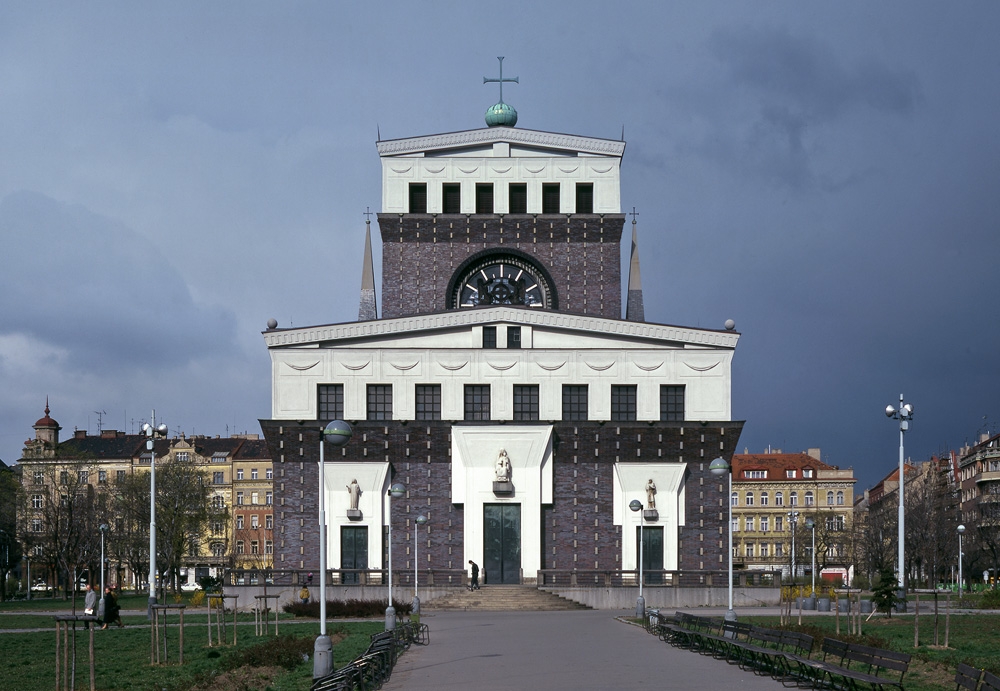
The church from the workshop of Josip Plečnik is one of the landmarks of Vinohrady
 |
| photo: Ester Havlová |
Prague – The Slovenian architect Josip Plečnik is primarily known in the Czech Republic as the author of the modifications to Prague Castle during the tenure of the first Czechoslovak president Tomáš Garrigue Masaryk. However, he also enhanced the city’s visage with another significant construction – the Church of the Most Sacred Heart of Our Lord in Jiří z Poděbrady Square, which has become a dominant feature of Vinohrady and part of Prague's panorama. The sanctuary, consecrated on May 8, 1932, is today a national cultural monument, but its inclusion on the UNESCO World Heritage List is not currently on the agenda.
The construction of the new Vinohrady church began to take shape even before World War I, with the "Society for the Construction of the Second Church of Our Lord in Royal Vinohrady" established in March 1914. The actual competition was announced in the first post-war year. The already respected architect did not participate in this competition; however, his students from the AAAD (Academy of Art, Architecture and Design), where Plečnik lectured from 1911 to 1921, succeeded. Later, the jury and reportedly even the competitors themselves invited him to develop the church’s design personally.
Plečnik completed it in 1927, significantly altering his original vision due to a lack of funds, which had envisioned a generous development of the area with additional buildings including a school, residential houses, or an archway. Plečnik created a total of three projects, without claiming any reward. In the final design, he reduced the anticipated costs to about a third. The foundation for financing the construction of the Church of the Most Sacred Heart of Our Lord became the so-called Beptovská Foundation. This managed the assets (mainly agricultural land) of the wealthy New Town councillor Karel Leopold Bepta, who donated it for church purposes.
In addition to this main source of funding, the entire parish contributed through many collections, donations, and a lottery. The total construction costs at that time reached approximately 4.8 million crowns. The cornerstone was laid on October 28, 1928, on the tenth anniversary of the founding of the Czechoslovak Republic. By 1932, a monumental postmodern hall structure with a wide tower, partially clad in cabřinc (a type of stone), partially whitewashed, had risen in the square. In designing the church, Plečnik drew inspiration from early Christian Mediterranean architecture. The cathedral was consecrated by the Archbishop of Prague, Cardinal Karel Kašpar, who also blessed six bells in the tower.
The rectangular hall measures 26 by 38 meters and has a height of 14 meters. The main tower is topped with a three-meter copper dome with a four-meter-high cross, reaching a height of 42 meters. The tower features a large round window with a diameter of 7.6 meters, which also serves as a clock. In the basement, there is a spacious chapel with a barrel vault, which contemporary architects consider Plečnik's most spiritual space. The interior of the church, which was largely created after the consecration, is as original as the exterior. Plečnik designed it himself, and after his return to his native Ljubljana, the work was taken over by the architect's successor Otto Rothmayer.
The sculptural decoration is the work of Damián Pešan, the Stations of the Cross were painted by František Doubek, and the colorful decoration of the windows featuring the Heart of Our Lord was designed by Karel Svolinský. The organs were manufactured by the Kutná Hora company Mölzer, and the bells were cast by the Brno workshop of Rudolf Manoušek. Plečnik also designed the modifications for the square. However, these were never completed, and moreover, the implemented modifications largely did not survive the later construction of underground shelters and the metro station, unlike the church, which is rightly regarded as the most significant domestic sacred building of the 20th century.
The English translation is powered by AI tool. Switch to Czech to view the original text source.
0 comments
add comment










